Mark Sisson's Blog, page 47
May 20, 2021
Stop Making What You Eat a Big Deal
 There was a time in my life when I spent every waking moment thinking about food. What I was going to eat, when I was going to eat it, and how much protein I could get in per meal. To put it simply, I was obsessed. And honestly, I’d tell anyone who’d listen what plan I was on and how freaking amazing I felt doing it (spoiler alert, I didn’t actually feel amazing).
There was a time in my life when I spent every waking moment thinking about food. What I was going to eat, when I was going to eat it, and how much protein I could get in per meal. To put it simply, I was obsessed. And honestly, I’d tell anyone who’d listen what plan I was on and how freaking amazing I felt doing it (spoiler alert, I didn’t actually feel amazing).
Here’s the thing though. When you make the program or plan that you’re following a big deal, it becomes THE THING you’re doing. Also, by the nature of it being a “thing” it inherently has a beginning and an end. If any of the following phrases sound familiar, read on.
“I’m eating low carb so I can lose weight.”
“We’re planning on doing keto this summer.”
“I do intermittent fasting, but I’m taking a break to enjoy vacation.”
As a health coach, I can empathize with those of you really do believe it’s a big deal. After all, you’re changing how you eat, you’re sharing your newfound wisdom with friends and family, you’re marching down the road to a better you. It’s exciting, I get it. Especially when you think you’ve found the secret weapon that will get you to your goal weight or goal-pair-of-pants.
Why You Obsess Over FoodFor one reason, it’s because food is everywhere. At home, in our social media feeds, at social gatherings, weddings, funerals, you name it. It’s how we celebrate, commiserate, and treat ourselves when we’re feeling bored, happy, sad, or stressed out.
And when we decide to follow a dietary plan that has specific rules (ie 1 gram of protein per pound of bodyweight, less than 20 grams of carbs a day), it suddenly becomes all we think about. Just imagine about how much energy is wasted planning and talking about food!
 I know meditation is good for me, but I don’t know how to start.
I know meditation is good for me, but I don’t know how to start.
I’ve tried to meditate before, but my mind is too busy.
It sounds easy, but it feels hard.
Not sure what the hype is all about? Find out why millions of people have been meditating for thousands of years.
Meditate with us for 21 days, complete with video meditations, a tracker, and community support!
Seriously, how many times have you been in a situation where you’ve proudly declared that you don’t eat bread? Or that you’re sugar-free. It’s like a badge of honor. Diet culture tells you that if you abide by a strict set of eating rules, you can be sure of three things:
You belong and fit inYou’re in controlYou’ll get validationYou’ve probably spent a lifetime getting bombarded by flawed beliefs about good health. These messages tell you that moderation isn’t meant to come easily. That food should always be judged and controlled. And that restriction is the price you’ve got to pay to prevent feeling fat, foggy, and fatigued.
How Personality Plays a RoleThere’s a term called Orthorexia Nervosa that describes what happens when health-conscious folks go too far.https://www.marksdailyapple.com/ortho... According to Dr. Steven Bratman, the holistic physician who coined the phrase, it’s involves having an extreme fixation with eating the right things and avoiding the wrong things at all costs, eventually impairing your mental, social, and physical well-being.
Following any strict set of rules can put you in this category, depending on your personality. In this study of 459 college students, researchers looked at whether orthorexia nervosa could be predicted from the demographic variables of gender and BMI, as well as the personality variables of self-esteem, narcissism, and perfectionism.https://pubmed.ncbi.nlm.nih.gov/27756...
After participants completed online questionnaires about healthy eating behaviours, problems resulting from those behaviours, and positive feelings associated with those behaviours, researchers concluded that men who had a higher BMI and men and women with traits of narcissism and perfectionism where more likely to develop disordered thinking around food.
5 Ways to Make Good Health EffortlessIf you’re tired of shouting from the rooftops, consider this: when you don’t feel the need to obsess about your dietary choices, you will never require permission or need to ask for forgiveness. You’ll never need a cheat day. And you’ll never fall off the wagon. Sound good to you? Here’s how you do it.
Ditch the “all or nothing” mindset. If you’ve ever decided you’d start eating healthy again tomorrow because you’d already *ruined* today, you know what I’m talking about. The “all or nothing” mindset is another way perfectionism gets in the way of progress. Life isn’t black and white. It’s filled with all sorts of ups and downs and inconsistencies. So instead of feeling the need to be super strict all the time or guilty if you ate a cookie, start getting comfortable living in the grey area, because that’s where real life happens.Keep an eye on the big picture. When you’re constantly counting calories, tracking macros, and declaring your disgust for bread, it’s easy to lose sight of what you really want. Take a step back and see your situation from a different point of view. Do you want to micromanage your food at every meal? Or would you rather be out there, enjoying life, not worrying if you go a gram over your carb intake for the day? Have a little faith in yourself and in the process.Eat to support your body. If you knew how hard your body works to support you, you’d treat it like the miraculous organism it is. Having an effortless relationship with food means that when you feel hungry, you respond by eating until you’re satiated. It’s not a sign that you should hold off on your next meal because you don’t have enough macros left. Just FYI, it also doesn’t mean that you’re being unkind to your body if you eat something you’d normally deem as unhealthy.Check your belief system. Society teaches us that happiness is condition based, meaning that once we reach our goal weight, or get the right job, or the right partner, we can be happy with where we are in life. This is a limiting belief, and it is most certainly standing in your way. The stories we tell ourselves create our subconscious reality, so if you have thoughts like, “I need to do paleo so I can be thin” or “keto is the only way to lose this muffin top” or “bread is the enemy” you’re only hurting yourself. This is your friendly health coach reminder that you are enough exactly as you are. You don’t need to squeeze all the carbs out of your day or break the world’s record on fasting to prove you’re worthy of belonging.Have self-compassion. When you have a kinder outlook toward yourself, you’re in a better position to make decisions about what’s best for your body. Research shows that the more understanding you can be, you’re more motivated to eat well.https://www.ncbi.nlm.nih.gov/pmc/arti... Not only that, it often keeps you from going off the rails which can happen if you feel like you’ve failed in some way. Self-compassion (and adopting a forgiving and curious mentality) helps you eat more mindfully, so that you don’t have to put a label on what you’re doing or how you’re eating.Is What You Eat a Big Deal?Everywhere you look people are shouting about food. So yeah, it’s hard not to make a big deal about what you eat. But what if you traded all the obsessing, micromanaging, and feeling guilt and shame for something a little more effortless? That might be just as rewarding. Get started by following these steps:
Ditch the “all or nothing” mindsetKeep an eye on the big pictureEat to support your bodyCheck your belief systemHave self-compassionGot something to add? Go ahead and share in the comments below.
(function($) { $("#dfjIbsr").load("https://www.marksdailyapple.com/wp-ad..." ); })( jQuery );
References https://www.marksdailyapple.com/orthorexia-healthy-eating-obsession/#ref-3https://pubmed.ncbi.nlm.nih.gov/27756637/https://www.ncbi.nlm.nih.gov/pmc/articles/PMC6534108/
The post Stop Making What You Eat a Big Deal appeared first on Mark's Daily Apple.



May 19, 2021
The Value of Eating What Your Ancestors Ate
 Everyone understands the intuitive power of eating the way our hunter-gatherer ancestors ate for hundreds of thousands of years. Sure, there’s a lot of variation throughout the eons. Changing climates and human migration patterns determined the culinary landscapes available to our ancestors, and the proportion of animals to plants in the diet varied across latitudes. There was no One Diet to Rule Them All, but there were patterns and trends that we can surmise and approximate. And we know what they didn’t have access to: the industrial foods of the modern era.
Everyone understands the intuitive power of eating the way our hunter-gatherer ancestors ate for hundreds of thousands of years. Sure, there’s a lot of variation throughout the eons. Changing climates and human migration patterns determined the culinary landscapes available to our ancestors, and the proportion of animals to plants in the diet varied across latitudes. There was no One Diet to Rule Them All, but there were patterns and trends that we can surmise and approximate. And we know what they didn’t have access to: the industrial foods of the modern era.
This way of eating works pretty well for most people who try it. It’s why the Primal Blueprint works, why the paleo diet works, and why, in general, the alternative (and even conventional) health world has increasingly looked to previous eras for guidance and to generate hypotheses on best health practices.
Okay, but what about the diets of your more recent ancestors?
Because if you take a look at the world today, you see incredible diversity. Hundreds of different ethnicities all of which emerged out of tens of thousands of years of population migrations and admixture events and bottlenecks and population replacements. In other words, a broad series of environmental pressure cookers created the world we inhabit today—and some of the most significant environmental pressures shaping modern human genomes have been dietary changes. While no one has adapted to the modern industrial diet, it seems intuitive that modern humans have adapted to some of those environmental pressures and that perhaps those changes can inform our dietary patterns today.
Don’t get me wrong: The basic machinery remains—the anatomically-modern human who produces insulin, metabolizes fats, carbohydrates, and ketones, requires protein and a range of micronutrients—but it’s in the margins that things have changed. And the margins are often where the interesting things happen.
I’m not suggesting that the basic Primal way of eating is outmoded. For what it’s worth, I think it’s still the best foundation for most people to eat, and the more “broken” a person is—obesity, metabolic syndrome, type 2 diabetes, digestive issues—the further back along their ancestral line they should look for health clues.
But once you’ve got things dialed in, you can start to explore higher up the ancestral chain—to graduate from hunter-gatherer to ancient pastoralist. This has the potential to optimize your physical health by tapping into those unquantifiable compounds unique to the food and your psychological health by honoring your ancestors. And even if it doesn’t improve your health in any appreciable way, it’s an opportunity to connect to your ancestors.
My experience is that eating the specific foods your direct ancestors consistently consumed resonates across your genome. This sounds ridiculous to the strict calorie-counter with a lifelong subscription to Cronometer, but consider that vitamins weren’t discovered til the early 20th century. Nutrition is still a young field. We know very little. There’s a lot in food that we’re probably missing, and those things could be interacting with your genes. Your genes might “expect” them, even if we can’t yet identify them.
Some of it we can predict and analyze. I think back to the time I had my own ancestry and DNA analyzed. Turns out I’m of Scandinavian stock, and some of my most recent ancestors were in Normandy (the part of France settled by Vikings). Sisson itself is a Norman surname, one that arrived on the shores of England in 1066 with the Norman invasion.
It also turns out that I need more long-chained omega-3s in the diet because my body isn’t very good at elongating short-chained omega-3s into the long-chained “marine” ones. I need to eat more fatty cold water fish—which happen to be some of my favorite foods—to get both omega-3s and vitamin D. Wouldn’t you know: both Vikings and Normans ate a ton of fish, including cod (whose livers are incredibly rich in vitamin D and DHA) and salmon (which is very high in omega-3s and decently high in vitamin D). Even the pork my Norman ancestors raised were high in omega-3s, as Norman pigs’ diets were supplemented with fish scraps.
It turns out that I have an elevated risk for soft tissue and connective tissue injuries, a likely indicator that I need more collagen and glycine in my diet. Sure enough, a mainstay in Viking, Norman, and medieval European diets in general were soups and stews made with animal bones and joints and skin rich in collagen. And here I am today, putting collagen in my coffee and even selling the stuff in stores across the world.
And then there are those strange connections you feel to certain foods. It goes beyond hunger, beyond “tasting good.” It’s more of a “feeling,” a sensation of connection, of warmth, of “this is right.” For me, it’s that cold sliced lamb leg with sharp cheddar and a side of raw onions—maybe the greatest, easiest lunch of all time. Certainly the most satisfying. Why? Am I recalling the the famed “salt meadow lamb” of northwestern France who feed on the salt-sprayed grasses of the coast? Could it be fenalår, the Norwegian salt-cured lamb leg I’m remembering?
Perhaps the specific ancestral foods of your specific ancestry unlock some secret dimension of your health. Probably impossible to measure or ever prove, but what if?
When I look at my genetic proclivities, the dietary habits of my Scandinavian and Norman ancestors, and the actual diet I’ve intuitively settled on, they all match up. There’s real value in this kind of analysis.
All else being equal, I assume that entire populations of people ate and lived a certain way because of adaptations to that diet and way of life. If a population “settles” on a way of eating for a good 1-2 thousand years, there are probably adaptations to that diet happening. We know that natural selection can happen incredibly quickly, and that humans are subject to this just like animals, bugs, bacteria. We’ve seen specific adaptations to specific foods, like lactase persistence after dairy’s introduction, and increased reliance on dietary omega-3s and a reduced ability to synthesize them in populations like Northern Euros who had access to lots of fatty cold water fish. You’ve even got the Inuit, who adapted to the Arctic food environment by improving fat metabolism and increasing the ability to generate heat from the food they eat.
Now, some people find this kind of content controversial. When I suggest something like this, I’ve had people say things like “even suggesting there are differences between human populations is wrong.” Some people worry it will feed divisions that already exist. Man, that’s a myopic view. I think the opposite is true. This is a way to celebrate our differences and connect to our past. It’s beautiful, really.
To me, it’s far more insulting and limiting to suggest that we are all identical to each other, carbon copies, interchangeable, fungible. That’s boring, and it’s frankly incorrect. Anyone with eyes (and taste buds) can take a look around and see that differences exist in the dietary habits and cuisines of different ethnic groups. These differences aren’t all arbitrary. There are hints at real physiological consequences for how we metabolize different foods.
In future posts, I can explore more of these interactions between specific ancestry and diet. For now, I’d love it if you guys gave this some thought.
What kind of foods were your recent ancestors eating? What did grandma make when you were a kid? What did grandma grow up eating?
Do you see any value in approaching diet and health from this angle?
Take care, everyone.
(function($) { $("#dfl21MO").load("https://www.marksdailyapple.com/wp-ad..." ); })( jQuery ); 
The post The Value of Eating What Your Ancestors Ate appeared first on Mark's Daily Apple.



May 18, 2021
Keto on the Trail: What to Pack for Primal and Keto Camping, Hiking, and Backpacking
 One of the upsides of indoor venues being closed this past year is that a lot of people have (re)discovered a love of the great outdoors. More people than ever seem to be venturing out on the trails, camping with their families, and generally taking advantage of nature. Although avid hikers and campers might lament the busyness of their once-isolated outdoor spaces, I think we can all agree that this is a good thing for society as a whole.
One of the upsides of indoor venues being closed this past year is that a lot of people have (re)discovered a love of the great outdoors. More people than ever seem to be venturing out on the trails, camping with their families, and generally taking advantage of nature. Although avid hikers and campers might lament the busyness of their once-isolated outdoor spaces, I think we can all agree that this is a good thing for society as a whole.
The food situation can be a barrier to entry, though. Traditional camping and hiking foods tend to be high-carb and grain-based, so Primal and keto outdoors enthusiasts may find themselves at a loss for what to eat. Portable, shelf-stable items like oatmeal, granola bars, sandwiches, pasta, and s’mores probably aren’t on your Primal menu. (You can make better-for-you s’mores that are pretty darn amazing!) Never fear. Plenty of Primal- and keto-friendly foods work just as well in these scenarios.
Conventional backpacking wisdom also suggests that hikers need to keep carb intake high to maintain energy and stamina. Not so! Primal and keto diets are ideal for camping and especially for hiking and backpacking. These sustained submaximal efforts rely largely on fat-burning for energy, at least for the metabolically flexible among us. A growing contingent of Primal, paleo, and keto backpackers are demonstrating in real time that it’s not only possible to fuel your outdoor adventures on a low-carb diet, it may actually be ideal.
Primal and Keto Camping FoodIf you’re packing a cooler, you can eat literally anything you would eat at home, provided it can be prepared or reheated on a camp stove or over a fire.
Your camping shopping list can look pretty much like your typical shopping list:
EggsMeat, poultry, seafoodVegetables and fruitNuts and seedsCoffee or teaCream, coconut milk, or nut milkCheese and yogurt if you eat dairyDon’t forget avocado oil, salt and pepper, other spices, and condiments to make your food taste delicious!
Personally, I prefer to do as much work as possible at home. Save time by pre-cooking bacon, chili, shredded chicken, taco meat, and hard-boiled eggs. Assemble kabobs to cook over the fire. Make low-carb muffins or pancakes if they’re on the menu. Once at the campsite, cook scrambled eggs, grill burgers and sausages, toss together salads, and so on.
However, if you won’t have a cooler, or if you’ll be backpacking, that’s another story altogether.
Primal and Keto Backpacking FoodHow Much Food To Bring
Backpacking food takes a lot more forethought than regular ol’ camping. Note that I include backcountry camping, where you have to pack in food, under the “backpacking” umbrella. Whenever you have to carry your food any significant distance, weight and space efficiency really matter. You don’t want to carry unnecessary food, nor do you want to be hungry and undernourished.
You should carefully consider how many calories you need each day, factoring in your activity level, how long you’ll be out in the wilderness, and if and when you’ll be able to resupply. Figuring out exactly how much to bring can be tricky, especially for Primal and keto folks. Usual recommendations are around 25 calories per pound of body weight per day, plus or minus 5 calories for easier or harder outings. However, one of the purported benefits of metabolic flexibility and efficiency is that you become less dependent on regular meals and possibly get away with fewer calories. Indeed, some low-carb hikers (and other endurance athletes) enjoy pushing the limits and seeing how little food they actually need. That can be a risky strategy, though.
Ultimately, you’ll need to figure out for yourself through trial and error exactly how many calories you need per day. Likewise, experiment to find your preferred macronutrient consumption on the trail. The Ketogenic Backpackers group on Facebook is a fantastic resource for seeing what other low-carbers are doing.
Primal and Keto Backpacking Meal and Snack IdeasThe main priorities when selecting backpacking food are weight and temperature stability. You can afford to bring a few perishable items to eat in the first day or two, but for longer treks, you don’t want to mess with possible food-borne illness.
Here are some options that fit the bill, require no cooking, and are also low-carb:
Grain-free granolaJerky, biltong, pemmicanOlives or dried olivesNuts and nut butter (available in single-serve packets)Trail mix, spiced roasted nutsHard salami, summer sausageHard cheese, freeze-dried cheeseTuna packets 0r other tinned fishWhole avocadosLow-carb protein barsLow-carb tortillasPowders Galore!You might be surprised how many food items you can get in powdered form, making for easy, lightweight packing. Many hikers take advantage of powdered vegetables, including single vegetables, vegetable blends, and green powders, to cover some of their nutrient bases.
Dairy products like heavy cream, various cheeses, sour cream, and butter come in powdered form. Can’t do dairy? Look for coconut milk powder. These can all add welcome flavor and much-needed fat and calories to your trail meals.
Coffee lovers can still have their morning brew thanks to instant coffee. We all know that Mark isn’t the biggest fan of fatty coffee in general, but in this case, it can be a delicious way. Some hikers even bring small battery-powered whisks so they can whip up instant “trail coffee” with powdered MCT oil (which can boost ketone production), heavy cream, butter, and/or coconut milk. Substitute instant tea if coffee isn’t your thing.
Lastly, don’t forget about protein powders and collagen peptides for valuable amino acids!
Hot Food Options for HikingIf you’re bringing a stove and heating water on the trail, the world is your (dehydrated) oyster! Most meats can be dehydrated unless they have a high fat content, as can eggs, vegetables, fruits, and legumes. Serious hikers probably want to invest in a dehydrator, which gives you almost endless possibilities for creating your own dehydrated meals to reconstitute on the trail. Make sure you take the time to learn the ins and outs of proper dehydrating so you don’t end up with spoiled food. Dehydrated ingredients are also readily available online.
When putting together meals, don’t forget to add herbs and spices for flavor, and bring fats to add during cooking (see below). Here are just a few ideas:
Soups made with powdered bone broth and any combo of meat and vegetables you wantBeef stewCurried cashew chicken“Hamburger helper” made with ground beef, powdered cheese, and grain-free noodles or dehydrated zucchini noodles, topped with dehydrated pickles (yes, that’s a thing)Cauliflower rice risotto with shrimp and mushroomsEgg scramblesHow about instant n’oatmeal? (That’s not-oatmeal, if you didn’t know.) Play around with different combinations of powdered cream or coconut milk, flax seeds, chia seeds, ground nuts or almond meal, dried coconut, freeze-dried berries, protein powder, salt, and spices like cinnamon or nutmeg to get the perfect flavor combination and macros for you.
If DIY isn’t your thing, a few brands already offer Primal-friendly and keto-friendly meals, with more options on the horizon, I’m guessing. Many traditional brands have at least a couple meals with appealing ingredients and macros, too.
Getting Enough Fat on the TrailAs I said, getting enough calories can be a challenge for any long-distance hikers, but especially those who are also practicing low-carb eating or intermittent fasting. Fat provides nine calories per gram, versus the four calories in protein and fat. Getting enough fat is essential, and it will make your trail food more appealing.
In addition to the powdered dairy and coconut products mentioned above, you can carry olive or avocado oil in food-safe silicone containers. Just make sure you double-bag them to prevent spillage in your backpack, and don’t mix fats into your dehydrated food until it’s time to cook them.
Coconut oil is another great option, and it comes in single-serving packets. For heat stability, you can’t beat cacao butter, but it does taste mildly like chocolate. That’s nice for your trail coffee, and it’s fantastic in chili, but it doesn’t work as a neutral oil.
Some hikers carry butter, but the USDA recommends not keeping butter at room temperature for more than two days.https://ask.usda.gov/s/article/Is-but... It’s okay for short hikes, but for longer hikes, especially in the heat… you do you.
Don’t Forget Your Electrolytes!Hopefully, keto folks are already well aware of the importance of electrolyte supplementation. That goes double during hiking. Hikers and backpackers are endurance athletes. All athletes need to make sure their electrolyte intake is sufficient, especially when they’re losing electrolytes through sweating.
Check out my recent post Ways to Get Your Electrolytes (That Aren’t Sports Drinks) for options.
Use Carbs Strategically If You WantThere’s nothing wrong with sticking to your usual low-carb macros on the trail. Hiking is a perfect opportunity to take advantage of that fat- and ketone-burning prowess you’ve worked so hard to build.
That said, adding a bit of dried fruit to your trail mix, noshing on a foraged piece of fresh fruit, or enjoying some dark chocolate at the end of the day is also a perfectly valid choice. Remember, metabolic flexibility means burning fat, ketones, and glucose when it’s available. Within reason, additional carbs probably won’t even kick you out of ketosis—not in the context of long, active days. It’s not necessary to up your carbs, but you shouldn’t worry that the keto police will come after you on the trail.
There are so many delicious low-carb meals that are well-suited to hiking and camping! Seasoned campers and hikers, please share your favorite Primal and keto meals and snacks in the comments!
(function($) { $("#dfrzgNK").load("https://www.marksdailyapple.com/wp-ad..." ); })( jQuery ); 
The post Keto on the Trail: What to Pack for Primal and Keto Camping, Hiking, and Backpacking appeared first on Mark's Daily Apple.

 [image error]
[image error]
May 14, 2021
New and Noteworthy: What I Read This Week — Edition 130
 Research of the Week
Research of the WeekTop men and women are hard at work trying to convince you to go on a plant-based diet.
Ivermectin combined with doxycycline looks to be an effective, inexpensive COVID treatment.
Neanderthals ate some starchy foods.
At least across the Southwestern United States, ancient human gut biomes were far more diverse than they are today.
Ancient enhancement of Amazonian soil quality made by pre-Columbian forest dwellers still persists today.
Episode 491: Dr. Jason Fung: Host Elle Russ chats with Dr. Jason Fung, a practicing nephrologist, best-selling author, and expert on intermittent fasting.
Episode 492: Dave McKeown: Host Brad Kearns chats with Dave McKeown about leadership.
Health Coach Radio: Erin and Laura chat with Elizabeth Tripp about creating your own experience and rewriting your own story.
Media, SchmediaLow-fat flavored (sugar-filled) milk is coming back to schools.
Texas may ban fake meat purveyors from calling their products “meat.”
Interesting Blog PostsHow to lower your LDL when you’re low-carb.
Social NotesRanchers: this is what you’re potentially missing out on.
Naps as productivity boosters.
Everything ElseHyenas massacred and ate this group of Neanderthals.
Ancient Pacific Coast dwellers had access to so much salmon that they had to impose limits to keep from eating too much. Nice problem to have, huh?
Things I’m Up to and Interested InPodcast I enjoyed doing: Mark Bell’s Power Project. Go listen.
Other podcast I enjoyed doing: Abel James’ Fat Burning Man. Go listen to that too.
Good interview: Robert Lustig on CNN about the dangers of processed food.
Bad news: Young kids have gained a ton of weight throughout the pandemic.
It always helps: Bad sleep? Exercise will improve your thinking.
Question I’m AskingWhat are you grilling this summer?
Recipe CornerI’m grilling this chicken.Grenadan fish and chicken stew.Time CapsuleOne year ago (May 8 – May 14)
Why Eating Less Doesn’t Always Work — Why not?Why Am I Getting Low Ketone Readings on a Ketogenic Diet? — Well, why am I?Comment of the Week
“Avocado Mayo: Great for fish sticks! Put mayo in a plastic bag with cut of fish, squish around until all are coated in mayo, roll in a mixture of crushed pork rinds, parmesan cheese, and smoked paprika or other spices. Cook in air fryer. Serve with chipotle lime Avocado mayo. Yum yum!”
-That sounds incredible, Carol.
(function($) { $("#dfxIx8C").load("https://www.marksdailyapple.com/wp-ad..." ); })( jQuery ); 
The post New and Noteworthy: What I Read This Week — Edition 130 appeared first on Mark's Daily Apple.



May 13, 2021
Ask a Health Coach: What’s Your Body Trying to Tell You?
Hey folks! This week, PHCI’s curriculum director, Erin Power is answering your questions about cheat days, how to handle hunger during intermittent fasting, and the best thing to do when you get the chills. Keep asking your questions over in the Mark’s Daily Apple Facebook group or post them in the comments below.
John asked:
“I’ve been doing intermittent fasting for a few months and it’s working well, but I get hungry after 14 hours or so. Wondering if it’s best to try to muscle through the hunger when I feel it kick in or should I just eat?”
There are several different ways to practice intermittent fasting and they all have proven disease-fighting and anti-agent benefits.1 There’s the popular 12:12, 16:8, 18:6, and 20:4 methods, alternate day fasting, multi-day fasting, and really any way you can slice a period of time. The best way to figure out which method is right for you though, is to experiment.
A longer fast may have worked for you in the past, but the human body is a miraculous and adaptable organism. What felt great at one point might not be in your best interest now. And if you’re feeling tempted to push yourself to resist eating for a few extra hours, thinking more is better, let me remind you that there’s no award given to the person who can fast the longest. You’re also not going to have your IF card pulled if you decide to eat outside your original window.
Everything about our culture seems to discourage us from listening to what our bodies are telling us. We somehow believe that other people know us better than we do.
Listen, if something isn’t working, my body will tell me, and I trust that. I try to teach my clients the same thing: to trust the signals they get from within; rather than relying on what a scientific paper, influencer, or so-called-expert tells them is going to prolong their life or bestow them with optimal health.
So, instead of pushing through the pain (or hunger in your case), what if you took that hunger as a sign? What if you honored your body by listening to your grumbling stomach and sluggish energy levels and gave it the fuel it was asking for?
 I know meditation is good for me, but I don’t know how to start.
I know meditation is good for me, but I don’t know how to start.
I’ve tried to meditate before, but my mind is too busy.
It sounds easy, but it feels hard.
Not sure what the hype is all about? Find out why millions of people have been meditating for thousands of years.
Meditate with us for 21 days, complete with video meditations, a tracker, and community support!
How Do You Recognize Your Body’s Signals?Stop a few times a day and take inventory of your body. Identify any sensations going on – what’s happening in your stomach, your jaw, your shoulders, your focus, and your mind.Record the negative and positive feelings you observe, then connect the dots. Is your focus starting to wane because you haven’t eaten in awhile? Are your shoulders tense because you haven’t stepped outside all day?Adjust as necessary. What happens when you decide to break your fast with an epic protein-forward meal vs continuing to muscle through the hunger? Are you satisfied and satiated instead of unfocused? Experiment with responding to your body’s signs and see what happens.As I mentioned, I’m a huge fan of listening to my body. If I’m hungry, I eat. I don’t starve myself or battle hunger pangs just because I’m following a program that generally says I should. That being said, you might want to ask yourself if you’re really hungry or if something else is at play.
Does your hunger kick in when you feel stressed at work? You’re trying to avoid a task? Or when you feel bored? Or is it that it’s been 14 hours and your body is ready for fuel? Only you know the answer and once you start to really listen to your body, you won’t have to second guess whether or not it’s time to eat.
Julie asked:
“Someone said they were having a “carb cheat day” for Menu Monday over on the Keto Reset Facebook page. Can you explain how a carb cheat day even works?”
There is some research to support having a “carb refeed” for those who have their insulin sensitivity dialed in, or who perform high intensity exercise on a regular basis – especially for women. But declaring a whole day a cheat day, in my opinion, is an excuse for allowing poor nutrition and lifestyle choices on a regular basis.
The whole concept of a cheat day just doesn’t sit right with me. And when you throw the term “carbs” into that phrase, it really lights me up.
Why Carbs Aren’t the EnemyCarbs come in a lot of forms, everything from tangerines and turnips to Twinkies. And, as a reminder, foods aren’t good or bad. They just have consequences. Eating a steady diet of processed foods will likely put you on the fast-track to disease, while eating a piece of fruit or a root veggie is called balance.
Depending on what this person’s take on carbs are, they could be binging on highly processed, nutritionally void food under the umbrella of a “cheat day,” feeling justified because they believe they deserve to have a 24-hour period of indulging as a reward for their dialed-in diet the rest of the week.
So, to answer your question, a carb cheat day could look like a big bowl oatmeal and fruit, followed by grilled sweet potatoes and squares of dark chocolate. Or it could look like pastries, pizzas, and beer on repeat.
You Shouldn’t Need to CheatI think the bigger question is, why does a person need a cheat day? I typically avoid using that term because it reinforces the diet culture mentality that what you’re doing the rest of the time involves suffering or deprivation in some way. That you’ve got to ignore all your body’s cues 6 days a week in order to reach your goals. Which is total BS in my opinion. White knuckling all week long can and will lead to some kind of consequence, trust me.
Personally, I’m a live-in-the-moment person and believe that life is nothing without treating yourself. But treats should be indulged in on occasion, instead of dedicating a whole day of derailment just to get your fix. I’d rather see someone with a healthy and balanced mindset so that “cheating” isn’t even on the table.
Andrew asked:
“From a primal perspective, when you get chills with a fever, is it better to listen to your body and seek warmth or does it make sense to go the opposite way and immerse yourself in cold temps to trigger an adaptation in immune system function?”
There are some pros to allowing your body to adapt, but in general, I’d take your chills as a sign that you should take steps to warm yourself up.2 Any time your body is fighting something off, it responds by increasing your body temperature. Submerge yourself in an ice bath or take a cold shower and you’re causing your body to work harder than it needs to.
I find it interesting that even if we feel awful and have limited energy, we believe that pushing ourselves is the answer. Feel cold? Let’s tough it out. Tired? You should probably fight the urge to sleep. Hungry? Go ahead and starve yourself for another hour or two.
Ignoring Needs is a Learned BehaviourIt’s ridiculous how much people ignore their internal signs. Like it somehow makes you weak to “give in” to the sensations you’re feeling in your body. But blocking these sensations or convincing yourself to suffer through them is a learned behaviour. And it’s something that can be unlearned.
What would happen if you allowed yourself to notice what’s going on in your body and take action on it? Life isn’t meant to be a suffer-fest. It doesn’t make you less bad ass to be in touch with your feelings. And it doesn’t make you less primal to grab a warm blanket when you’ve got the chills.
Practice listening to your body and see what happens. You might be really surprised by what it’s telling you.
Are you team ‘listen to your body’ or are you more used to ignoring your internal cues?
(function($) { $("#df76mIJ").load("https://www.marksdailyapple.com/wp-ad..." ); })( jQuery );
The post Ask a Health Coach: What’s Your Body Trying to Tell You? appeared first on Mark's Daily Apple.



May 12, 2021
How to Grill Everything – the Ultimate Guide
[image error]June looms. Summer is almost upon us. The sun’s out, people are starting to gather and mingle, the big box stores are stocking charcoal again, and those chicken drumsticks, that tri tip, that lamb leg, and that salmon filet behind the butcher counter are looking good. You feel the pull of the grill. It calls to you. You need to respond—but how to do it?
Not everyone is a grill master. With baking and traditional recipes, you can follow along just by reading. Oven temperatures and controlled gas ranges make cooking indoors fairly predictable. But outside, out on the grill, things get a little wild.
Grilling is more art than science. It’s about feeling the meat, sensing the heat, intuiting what’s happening beneath and above the grill. The wind, the coals, the flame, the air flow, the ambient temperature all affect and determine the quality of the finished product. It’s all too much to plug into a spreadsheet and figure out down to the millisecond. There are no guarantees. So while I’m going to give you the best methods I’ve learned over the years, don’t take this as settled science. You’re going to have to experiment for yourself.
Today I’ll go over the most frequently asked questions I see about grilling.
How to Determine the Proper Grill TemperatureWhen you grill, you want areas of high, medium, and low heat accessible at all times. This gives you the ability to modulate the amount of heat your food receives and it gives you more flexibility when cooking. Whether you’re using coals or gas, you can determine the temperature ranges by using feel—actually feeling the heat with your hands. If you can keep your hand a couple inches off the grill only for under a second before it gets too hot, that’s high heat. If you can keep your hand there for 2 seconds, that’s medium heat. If you can keep your hand there for 3-5 seconds, that’s low heat.
How to Determine Meat Doneness
You can use an instant read digital thermometer inserted into the thickest part of whatever you’re grilling. This is more precise and it’s a good way to develop your intuition if you pair it with learning by feel. This is a good one that’s served me well.
Rare: In a chef’s mind, rare means very pink, is closer to 125 degreesMedium-rare: You’re looking for 125-130 degreesMedium: 130-135 degreesMedium-well: 135 to 140 degreesWell done: 140 and aboveYou can also determine doneness by touching your meat, by prodding it, by poking it, by squeezing it. With enough time and trial by error (and using the thermometer to confirm), you can eventually figure out if the meat is ready by how it responds to your manual manipulation, but in general:
Rare is squishy.
Medium-rare is spongy.
Medium-well is firm.
Whatever you do, err on the side of taking it off the heat early. You can always add more cooking time if it’s undercooked, but you can’t take it away.
How to Grill Burgers[image error]
Some people like to complicate the burger. They include exotic spices, incorporate cheese or grilled onions into the meat itself, and pre-form them. For my money, the best way to grill a burger is to pack about 1/4-1/2 pound burger meat loosely together right before you throw them on the grill—packed enough that it stays together but not so tight that it becomes a brick. Don’t mix salt into the burger meat, because that will alter the structure of the meat and give it a sausage texture.
Fun fact: Primal Kitchen® just updated the Ranch Dressing recipe, adding organic egg yolks, a natural emulsifier, for a thicker, creamier dressing that’s still dairy-free.
How Long to Grill Burgers
Season it heavily with kosher salt and black pepper on both sides and grill over medium-high heat for 1-2 minutes per side. Then flip again and grill for 1 minute on each side, turning the burger 90 degrees so you get grill cross marks. Move burger off to the side to finish cooking on indirect or low heat for another few minutes, adding cheese to melt at this point if you are so inclined.
How to Grill Thick SteakTo grill a thick steak like a ribeye, a NY strip, a porterhouse, or a filet mignon, you’ll need to use a combination of high heat and low heat. First, season all sides, including the edges, with kosher salt and pepper. Be generous. Then, rub a little olive or avocado oil all over the meat and place on a pre-heated grill over high heat for 2 minutes. Flip and grill another 2 minutes. Flip again, turning the meat 90 degrees to get the hash grill marks. Flip again after a minute, again turning the meat to get the hash marks. After a minute, move the steak off the coals/flame to cook indirectly for another 2-4 minutes with the cover on, flipping midway through and making sure any fat caps are pointed toward the heat source. Gotta render that down.
Adjust time depending on thickness, of course. These are just guidelines and ranges.
If you prefer, you can begin with indirect heat and finish with high heat. Both work great.
You can also smear Primal Kitchen mayo all over your salted-and-peppered steak instead of oil before applying high heat. Gives a great crust.
After it’s off the grill, let it rest for 10 minutes before slicing into it. And always slice against the grain.
How to Grill Thin SteakTo grill a thinner steak like skirt, flap, flat iron, hanger, or flank, you’ll want to stick to medium-high heat. Add kosher salt and pepper and any other seasonings you want (or marinade 12-24 hours before, as thinner steaks do great with marinades), spray or drizzle olive or avocado oil, and toss it on the grill over medium high heat for 2-3 minutes per side. Place on indirect or low heat to finish.
Make sure you let the steak rest for 5 minutes and cut against the grain.
How to Grill Salmon[image error]
Season your salmon on both sides, spray it down or drizzle with olive or avocado oil, and place it skin-side down on a heated grill over medium heat for 3-5 minutes. When the meat-side facing up begins to dry out and you can see the cooked portion of the meat inch up along the side toward the midpoint of the filet, flip it over and grill for another 2 minutes. Move off the heat to finish indirectly.
I can’t recommend grilling salmon directly on the grill without the skin because it always sticks to the grill. I’ve never found a good replacement. What you can do is place the salmon on a cedar plank and cook it for 20-30 minutes. This is a slower, gentler cook.
How Long to Grill SalmonBecause salmon is so varied in thickness and fat content, it’s hard to give one number that encompasses every piece of salmon. What works best is what not to do. If you get the white stuff forming on the meat, you’ve gone too long. Take it off before the white stuff happens.
How to Grill Chicken BreastTo grill chicken breast, season it well, drizzle it with olive oil, and grill it until well-browned on all sides (about 3 minutes per side), then move to indirect heat, cover the grill, and let it cook until done.
An alternative method is to smash the chicken breast flat with a meat mallet, season it, and grill it over medium high heat for 10 minutes. Much quicker this way.
Recipe to try: Devyn’s Grilled Marinated Chicken
How Long to Grill Chicken BreastConfirm that it’s done with a digital thermometer or by feel (if you’re confident in your intuition). Conventional wisdom says chicken breast must reach 165°F to be safe, but you can take it off at 157° and let it rest for 10 minutes. Residual heat will cause the internal temp to rise to a safe level and you won’t dry out your breasts.
Bone-in breast will take longer to cook, but it will also be juicier since the bone protects the meat from drying out.
How to Grill Chicken Thighs

Chicken thighs are more forgiving than chicken breast. All that collagen and connective tissue and fat keep the meat moist, even at higher temperatures and longer cooking times. But if you want to realize the thigh’s potential and enjoy mouth-watering, unctuous meat ribboned with melting collagen, you need to cook it long enough to break down all that connective tissue.
How Long to Grill Chicken ThighsA chicken thigh can get by with just salt and pepper—or maybe a citrus-based marinade. Medium heat is ideal, about 8 minutes per side, and then another 5-8 minutes over indirect heat. As long as you keep it from burning, it will stay moist and juicy.
How to Grill Whole ChickenTo grill a whole chicken, you have to spatchcock the bird: remove the back bone, lay the bird out flat, and press down hard on the breasts until you hear a pop. Then season it with kosher salt and pepper (and other spices, if you desire, like paprika, garlic, and turmeric) all over, rub some avocado oil on, and place it skin side up on the grill. If you’re cooking with charcoal, pile up the charcoal over to one side and put the bird on the opposite end with the drumsticks closest to the coals. If you’re cooking with gas, leave half of the grill unlit and fire up the other half, putting the bird on the unlit half with its legs pointing toward the flames. Cover.
After about an hour, check the chicken. Grab the drumsticks and jiggle the legs. If they’re breaking free and the juice runs clear, the connective tissue has broken down and you’re almost done. Take the chicken and flip it over, skin side down, directly over the coals, for 5 minutes. Then it’s done.
How to Grill Pork ChopsThe pork chop is an underrated cut. Even by me. I always forget to get pork chops, they always slip my mind, but I’m always happy when I do remember. Some salt, some pepper, some avocado oil, medium high heat, time is all you need for a great grilled pork chop. The charred fat cap is really tough to beat.
I treat grilled pork chops like steak. I sear for two minutes, flip and sear for two minutes, flip (turning 90 degrees to get the good grill marks) and sear for 1 minute, flip (turning 90 degrees) and sear for 1 minute. Then move off to the side to finish cooking over indirect heat.
How Long to Grill Pork ChopsWith pork, you want to use a thermometer to determine how long to grill it. If I’m eating quality pork, ideally pasture-raised, I’ll serve it medium. That means I pull it at 130-135° and then letting it continue warming up a bit more. There will be a light pink tinge running through the meat and plenty of juice.
How to Grill RibsYou can’t really grill baby back or spare ribs from start to finish like steaks if you’re looking for that fall-off-the-bone texture. It takes a long time. You need to start with indirect low heat for 2 to 2 and a half hours. Season your ribs, paint them with sauce if you prefer, place bone side down on the grill, cover the grill, and cook them on low until they slide off the bone easily.
Another way to do it is to pre-cook your ribs in the oven, on the stove, or in the pressure cooker. Use a mixture of water, broth, vinegar, and sauce and various other seasonings and braise/boil/pressure cook the ribs until they’re tender. Refrigerate them until you’re ready to grill, then add more sauce to the ribs and quickly grill them over medium high heat on both sides until warmed through and seared.
These methods work for beef ribs, too, but you’ll need more time to get them tender.
How to Grill ShrimpShrimp grill up real quick—almost too quick. If you grill them long enough to develop the Maillard reaction, they often overcook and turn rubbery. Here’s how you overcome it:
Grill with the shells on. The shells protect the meat from overcooking and impart extra flavor to the finished dish. I love shell-on shrimp and actually eat the shells if they’re cooked well; they actually provide prebiotic “fiber.”Instead of spacing the shrimp out, pack them close together on the skewer. This protects the meat from drying out.Choose the largest shrimp you can find. The larger they are, the more heat they can handle before drying out.Grill over high heat, 2-3 minutes per side (depending on size).Finish with salt and lemon juice.
How to Grill Asparagus

Trim your asparagus and toss it in a large bowl with olive oil, salt, and pepper until completely coated. Place on the grill perpendicular to the grates over medium heat. When you see grill lines form, roll the asparagus 90 degrees. Continue this until there are prominent grill lines encircling the entire stalk of asparagus. Remove from heat and squeeze half a lemon over the asparagus. Serve with lemon juice whisked into mayo on the side for dipping.
While this isn’t an exhaustive list of everything there is to grill, it covers just about all the things you’ll want to grill on a regular basis. Leave me your thoughts down below and let me know what you love to grill and how to do it.
Take care, everyone.
(function($) { $("#dfNTspe").load("https://www.marksdailyapple.com/wp-ad..." ); })( jQuery ); 
The post How to Grill Everything – the Ultimate Guide appeared first on Mark's Daily Apple.
 [image error]
[image error]
[image error]
[image error]
May 11, 2021
Habit Stacking Microworkouts (aka Working Out Without Having to Think About It)
 The beauty of microworkouts is that you can do them virtually anywhere with minimal time investment, and the cumulative training effect really adds up… if you remember to do them.
The beauty of microworkouts is that you can do them virtually anywhere with minimal time investment, and the cumulative training effect really adds up… if you remember to do them.
To be successful with microworkouts, or any form of exercise, consistency is key. Not rigidity—we’re not big fans of rigidly adhering to a strict exercise schedule here—but you need to put in the time and effort. Workouts that don’t happen don’t change you. Unlike going to the gym or taking a Crossfit class, which you might schedule into your busy calendar, microworkouts are meant to be sprinkled throughout your day. Unfortunately, that makes microworkouts all too easy to forget or push off, until you get to dinnertime and realize you’ve barely moved your body all day.
If this sounds familiar, it’s time to get some systems in place to make microworkouts a built-in part of your day. This is a roundabout way of saying: you need to make microworkouts a habit.
Changing Habits: The Not-so-secret SecretsHabits are behaviors that have become so automatic that you do them with little to no conscious effort. Locking in new habits is no easy feat, though. We’ve all experienced the ups and downs of trying to make new healthy habits stick.
However, the process of habit change is actually quite simple when you break it down. When you’re trying to establish a new habit, you need:
Cues, or signals, that remind your brain to do the thing (in this case, to do a microworkout)Belief that you have the resources (time, knowledge, money) to do the thingDesire to do the thingReward or positive reinforcement after you do the thing that makes you want to do it againToday, we’re focusing on the first: cues that remind you to do your microworkouts. Specifically, we’re leveraging a trick called habit stacking.
With habit stacking, you use behaviors you already do automatically as cues to do the new desired behaviors. In this case, it means pairing everyday behaviors like brushing your teeth, making coffee, or walking out the front door with specific exercises like push-ups or going for a walk. Don’t worry, this will become self-explanatory shortly.
What Are Microworkouts Anyway?Microworkouts are short bursts of movement that you insert into your day. We’ve been tricked into thinking that the best, or only, way to be fit and healthy is to spend 90 minutes at the gym pushing plates or huffing and puffing through a 50-minute cardio kickboxing class. Not so. While athletes with specialized aims—run a marathon, deadlift twice their bodyweight—need to do specific workouts tailored to their goals, for general wellness, smaller efforts really do add up. You can log a very respectable amount of movement via short workouts lasting as little as 20 or 30 seconds, up to a few minutes, when you do them throughout the day.
Almost anything can count as a microworkout, as long as you’re moving. Microworkouts can encompass HIIT or Tabata-type activities; resistance exercises using bodyweight, exercise bands, free weights, TRX straps, or any other equipment you have on hand; or aerobic activities like going for a short walk.
Don’t overthink it. Any (quick) activity that builds muscular strength or endurance, cardiovascular fitness, even balance or flexibility falls under the microworkout umbrella. Ideally, you want to incorporate a range of movements that engage different muscle groups.
Habit Stacking: Linking Microworkouts to Habits You Do AnywayBelow are 25 ideas for using habit stacking to facilitate microworkouts. Use these as inspiration, but feel free to mix and match them to suit your life.
One safety note, first: Use appropriate caution when transitioning from sitting or lying down to exercising. You may want to perform a light warm-up movement first, especially before exercises involving heavy weights or a large range of motion. Check out the section entitled “How To Incorporate Microworkouts” in Mark’s earlier post here for more details.
25 Ways to Habit Stack MicroworkoutsWake up + do some dynamic stretching
Brush teeth + gentle leg raises
Brew first morning coffee or tea + sun salutation
Turn on computer + tech neck exercises
Check your calendar or to-do list+ jump squats*
Open social media app + mountain climbers*
End a Zoom meeting + walk to the end of the driveway and back, or take a lap around your building
Hang up a phone call + triceps dips*
Close a browser window + biceps curls
Refill your water + kettlebell swings*
Refill your coffee or tea + incline pushups against the edge of the counter
Start the microwave + run in place
Run the blender + hold a plank
Finish lunch + Mark’s road warrior workout
Use the bathroom + pull-ups (or one of these alternatives if you don’t have a bar)
Go up stairs + calf raises on the bottom step
Walk out the front door + jump squats*
Run the vacuum + alternating lunges*
Folding laundry + V-sits*
While watching TV, food commercial = flutter kicks*
Pharmaceutical commercial = glute bridges*
Insurance commercial = elbow-to-knee side planks*
Car commercial = burpees*
All other commercials = Grok squat hold
Brush teeth at night + wall sit*
*These exercises are described in A to Z Microworkouts to Weave Into Your Day
Handy TipsThe more specific you are about your intentions, the better. Don’t just say, “I’ll move more during commercial breaks.” Instead, say, “I’ll do 20 jumping jacks during every commercial break.”
Tailor the movements to your fitness level. If regular push-ups are too difficult, try wall push-ups. On the other hand, if they’re too easy, do one leg push-ups or dead stop push-ups instead.
Make use of whatever equipment you have on hand, and improvise with things like water jugs for upright rows or bags of garden dirt for heavy carries.
Leave yourself reminders. Put sticky notes on the coffee maker, bathroom mirror, or microwave. Leave your exercise bands hanging on the fridge door and your kettlebell in the middle of the office where you’ll see it. Get your family members or housemates involved so they help prod you to move.
Start by implementing a few at a time. Pick two or three cues you know will stand out—for me, it’s making coffee, checking social media, and refilling my trusty water cup—and pair them with distinct exercises that work different body parts. Once you are good about doing those exercises, add one or two more. Pretty soon, you’ll be moving considerably more during the day!
Tell us: What has helped you implement microworkouts into your day?
(function($) { $("#df88MFZ").load("https://www.marksdailyapple.com/wp-ad..." ); })( jQuery ); 
The post Habit Stacking Microworkouts (aka Working Out Without Having to Think About It) appeared first on Mark's Daily Apple.



May 8, 2021
How to Buy and Cook the Perfect Steak
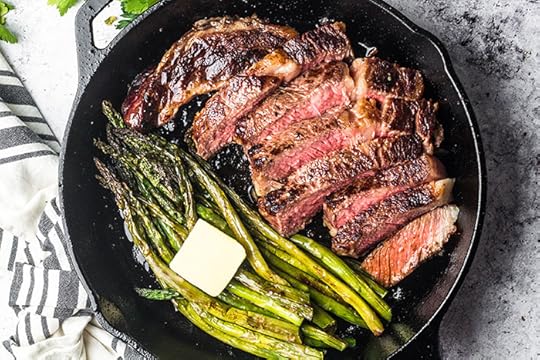 Crisp and caramelized on the outside, but never burnt. A first bite that melts in your mouth as the savory, perfectly seasoned flavor of beef hits your palate. The rich, smoky aroma of animal fat dripping onto an open fire.
Crisp and caramelized on the outside, but never burnt. A first bite that melts in your mouth as the savory, perfectly seasoned flavor of beef hits your palate. The rich, smoky aroma of animal fat dripping onto an open fire.
That, my friends, is a perfect steak. You don’t have to make reservations at an expensive steakhouse to reach this sort of steak nirvana. It can be yours any night of week in your own kitchen by following a few simple and painless steps.
Navigating the Meat CaseFirst things first – you’ve got to buy the steak. To understand the meat case at a butcher shop, you must first understand your cuts of meat. Close your eyes and visualize standing in a field while looking at the side of a cow or steer. The first cut of meat behind the head is the shoulder, known in butchery terms as the chuck. Although flavorful, the often-used shoulder muscle is mostly tough and full of connective tissue. The meat from this section of a cow is less expensive and primarily used for slow-cooked roasts. However, if you’re looking for a bargain, a top blade steak, also called a flatiron, is a flavorful, fairly tender chuck steak to throw on the grill.
Next in the line-up, anatomically speaking, are the portions of a cow that butchers call the rib, short loin and sirloin. The meat from this top, middle area of the cow is the most tender, since the muscles move the least during a cow’s life (as compared to the shoulder, hind end and shank). From these three larger cuts come most of the steaks you see at the market.
Rib or Ribeye Steaks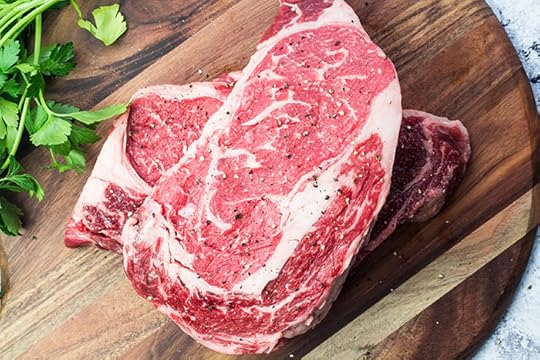 Rib steaks are basically a prime rib roast cut into portions, with or without the bone.
Rib steaks are basically a prime rib roast cut into portions, with or without the bone.
A rib steak has the bone attached, but the more popular ribeye steak has had the bone removed. The ribeye is also sold as a Spencer steak in the western U.S., and Delmonico steak in the East. Rib steaks usually have large pockets of fat, which add flavor and give the steak a moist, juicy texture.
Short Loin Steaks
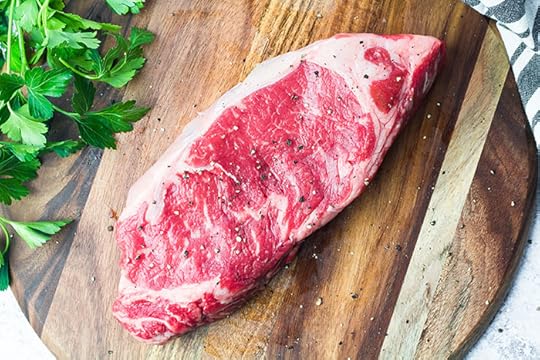
Short loin steaks are cut from the area below the backbone. There, you’ll find tenderloin or filet mignon, strip steak, New York strip, porterhouse, and others. is home to some of the most tender and popular cuts of beef, such as the Tenderloin, Strip Steak, T-Bone and Porterhouse Steaks. Loin cuts are great prepared on the grill or under a broiler.
Which Short Loin Steak Is Best?Some people find a long, narrow and slightly triangular top loin steak to be less tender than a rib eye and miss the extra ripples of fat. Others think a top loin steak has just the right balance of flavor and tenderness, without being too fatty. When it has a bone, a top loin steak is known as a shell steak. When the bone is removed it goes by many names: a strip steak, Kansas City strip, New York strip and sirloin strip steak, (which, confusingly, comes from the short loin, not the sirloin) are all the same cut of steak.
Tenderloin, Chateaubriand, and Filet MignonAlso cut from the short loin portion of a cow is the tenderloin, a portion of meat considered to be extremely tender (hence the name). Tenderloins are easy to recognize in the meat case, due to a long, cylindrical shape that’s thicker on one end then tapers down. A tenderloin is cut into many different types of steak, and all are pretty pricey. The thickest part (usually about 3 inches thick) of the tenderloin is cut into a steak known as chateaubriand. Filet mignon (also known as tenderloin steak) is cut from the meat behind the chateaubriand and is slightly less thick. Filet Mignon is thought to be the most tender part of the tenderloin, but on the downside, the flavor can be pretty mild.
T-bone Steaks
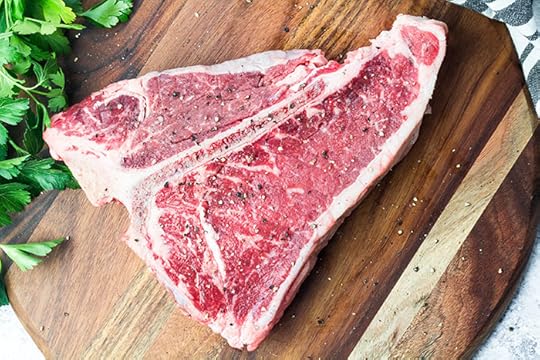
Last but not least, the short loin gives us the t-bone, a steak named for, you guessed it, a “T” shaped bone that runs down the middle. On one side of the bone is meat from the top loin, and on the other is a thin strip of tenderloin. Some say this steak combines the best of both worlds: the tenderness of a tenderloin steak and the rich, “meaty” flavor of a top loin steak.
If you’re really hungry, skip the T-bone and go straight for the porterhouse, which is simply a t-bone steak with a bigger portion of tenderloin attached.
Sirloin Steak
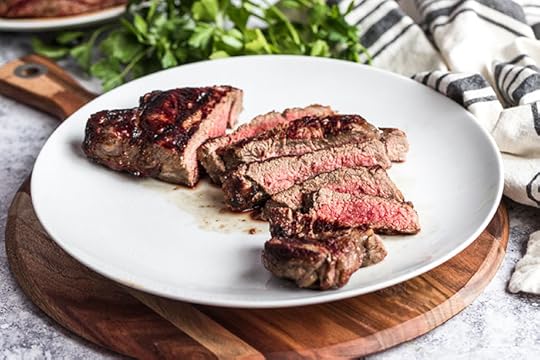
The sirloin is basically the cow’s hip. Sirloin steaks are usually fairly large but thin, and the meat is both moderately flavorful and moderately tender. Steaks from this region of a cow tend to be a good value. The most well-known among them are the top sirloin steak and the tri-tip, both boneless. Lesser-known steaks cut from the sirloin are the pin-bone, flat-bone, round-bone and wedge-bone steaks.
Directly below the loin and sirloin, on the underside of the cow’s belly, is the flank. Flank steak is a thin, wide, boneless cut with a texture (grain) that looks very stringy. Cooked very quickly to medium-rare and sliced thinly against the grain, the chewy texture is less noticeable and you will be rewarded with rich flavor.
Seasoning the Meat
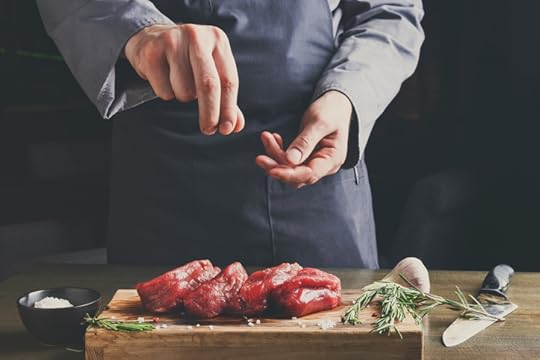
If a high-quality cut of meat is cooked correctly, you really don’t need much more than salt and pepper. Which makes one think that seasoning a steak is a very short topic, until of course, you consider the hotly debated “salt early” and “salt late” theories.
Cooking Steak: Salt Early vs. Salt LateThe Salt Early Theory: Salting meat many hours or even days before cooking breaks down the protein in meat and makes it more tender. Initially, the salt draws out moisture, but over time the meat re-absorbs the moisture, which is now flavored with salt and therefore adds more succulent flavor to the meat.
The Salt Late Theory: Salt dries meat out. Period. Don’t add it until immediately before cooking.
In this debate, we take the middle road. In our experience, the salt early theory rings true with larger or tougher cuts of beef. For your average steak, salting about a half-hour before cooking is ideal and seasoning right before cooking works just fine, too.
Before seasoning, always make sure to pat the steak dry. Some people like to brush the steak with oil (avoid olive oil, which can become bitter at high heats) or a combination of melted butter and oil before seasoning to help the outside of the steak brown. Season both sides of the steak, using a teaspoon or less of both salt and pepper. Remember, you can always add more seasoning after the steak cooks, but you can’t un-salt the meat.
After seasoning, let the meat sit on the counter for a bit so it comes up to room temperature (a good rule of thumb is at least 10 minutes for every inch of thickness).
If you want to branch out from salt and pepper, marinades and rubs can be used on any type of steak, but are an especially great way to bring flavor to less-expensive cuts.
Cooking Methods
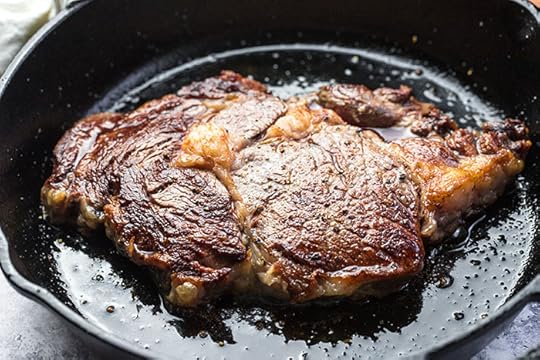
What we love about cooking steak on the stove is how easy it is to get a crisp, caramelized coating on the outside of the steak without over-cooking the middle. More often than not, this is harder to achieve on a grill. Using a combination of the stove-top and the oven is a tried and true method for perfect steak. The question is, which comes first?
How to Cook a Steak in the Oven and Cast Iron Skillet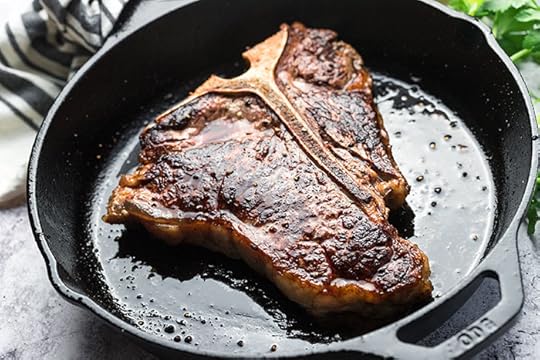 The most common method is searing the steak first on the stove, then finishing it in a hot oven.Pat dry and season the steak.Pre-heat the oven to 450-500 degrees Fahrenheit.When the oven is up to temp, drizzle a little oil in an oven-proof pan (cast iron works great) and then heat the pan on the stove over high heat for several minutes until it just barely starts to smoke (you can give the pan a head start by putting it in the oven while it preheats).Drop the steak in the pan and let it sit without touching it for 3 minutes. Be prepared to turn on your fan or open some windows, as there will be smoke.If the steak is stuck to the pan, it’s not done browning yet and needs a little more time. If it comes up relatively easily after 3 minutes, flip the steak.Put the pan, with the steak in it, in the oven.Let it bake for several minutes, then check by temperature or texture for doneness.Reverse Sear Method of Cooking Steak
The most common method is searing the steak first on the stove, then finishing it in a hot oven.Pat dry and season the steak.Pre-heat the oven to 450-500 degrees Fahrenheit.When the oven is up to temp, drizzle a little oil in an oven-proof pan (cast iron works great) and then heat the pan on the stove over high heat for several minutes until it just barely starts to smoke (you can give the pan a head start by putting it in the oven while it preheats).Drop the steak in the pan and let it sit without touching it for 3 minutes. Be prepared to turn on your fan or open some windows, as there will be smoke.If the steak is stuck to the pan, it’s not done browning yet and needs a little more time. If it comes up relatively easily after 3 minutes, flip the steak.Put the pan, with the steak in it, in the oven.Let it bake for several minutes, then check by temperature or texture for doneness.Reverse Sear Method of Cooking Steak A small but vocal population of steak lovers swears by the “reverse sear” technique. The theory behind this method is that cooking the steak in the oven first will dry the outside of the steak while slowly cooking the inside and keeping it tender. If the outside of the steak is dry, it will then sear faster and more efficiently in a hot pan.Pat dry and season the steak.Preheat the oven to 275 degrees Fahrenheit.Place a wire cooling rack on a cookie sheet then put the steak on the cooling rack. This allows hot air to circulate around the entire steak.Bake the steak until the internal temperature is 100-110 degrees.Drizzle a little oil in a pan over high heat. Just as the pan begins to smoke, drop the steak in the pan.Cook the steak for 2 minutes on each side.
A small but vocal population of steak lovers swears by the “reverse sear” technique. The theory behind this method is that cooking the steak in the oven first will dry the outside of the steak while slowly cooking the inside and keeping it tender. If the outside of the steak is dry, it will then sear faster and more efficiently in a hot pan.Pat dry and season the steak.Preheat the oven to 275 degrees Fahrenheit.Place a wire cooling rack on a cookie sheet then put the steak on the cooling rack. This allows hot air to circulate around the entire steak.Bake the steak until the internal temperature is 100-110 degrees.Drizzle a little oil in a pan over high heat. Just as the pan begins to smoke, drop the steak in the pan.Cook the steak for 2 minutes on each side.So does this method really yield a more perfect steak? We have to admit, it did brown the outside of the steak very nicely while leaving the inside really juicy and tender. As a bonus, you get nice grill marks from baking the meat on the cooling rack. Give it a try, and you be the judge.
Grilling Steak on an Outdoor GrillIn some people’s minds, however, the only way to cook a steak is over an open flame in the great outdoors. Many of these same people consider grilling an art form that cannot be mastered overnight. It takes years of experimenting with different types of grills, different heat levels and cooking times and various seasonings and marinades. This may be true for some fanatics out there, but we feel pretty confident that you’ll get a great steak the first time out if you pay attention to a few key things.
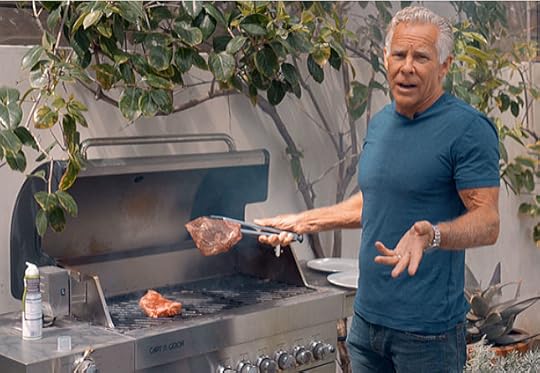
The “charcoal vs gas” debate is one that has gone for decades, and we think they both have their place. For convenience and the easy ability to control heat levels, a gas grill can’t be beat. For depth of flavor, charcoal usually wins out.
Either way, you never want to put a steak on a cold grill. Wait until it heats up. For a gas grill, this is easy. Simply turn the knob to medium-high and keep the lid closed for 10-15 minutes. For a charcoal grill, the type of charcoal you use will affect the heat level as well as the flavor of the meat. Briquettes are easy to light, hold steady heat and are inexpensive, but they are also made with questionable additives that can give meat a chemical flavor. We favor hardwood charcoal (made from oak, hickory, mesquite, etc) for a natural, smoky flavor. Hardwood charcoal can be a little trickier to light and once it gets going it burns hotter and more unpredictably, which requires keeping a closer eye on the grill. A small price to pay, we think.
There is no point in using hardwood charcoal and then dousing it in lighter fluid, which will make your meat taste like it was marinated in petroleum. Instead, use a charcoal chimney starter to stack and light the coals. Once the coals are lit (usually about 30 coals are needed to provide adequate heat) wait until they change from bright red to an ashy white, which usually takes at least 20 minutes. Spread the coals out, placing most of them on one side to create a high heat side and a few on the other side of the grill to create a low heat side. Cover the grill for about five minutes so the heat builds to medium-high. To test the heat, simply hold your hand a few inches above the grill. If you can’t hold it there for more then 2 seconds, you’ve got high heat. If you can hold it there for 4-6 seconds without pulling away, the heat is medium-high.
Now, you’re ready to cook. Start by placing the steak (patted dry, seasoned and close to room temp.) over medium-high heat for at least 3 minutes without turning. This is about right for a 1-inch steak; thicker steaks will need another minute or two. Flip, and grill the other side for another 3 minutes. This should brown both sides and bring the steak to the brink of medium-rare.
To bring the steak up to desired doneness, move it to an area of the grill that has less-intense heat. Close the lid and cook for another 3-5 minutes before checking if it’s ready.
Although flames add excitement to grilling, they do nothing for the meat but burn it. Move the steak away from flare-ups as soon as they occur. In general, try to move the steak as little as possible while it cooks – too much movement prevents the steak from searing and getting a crispy, brown coating.
Is It Perfect Yet?
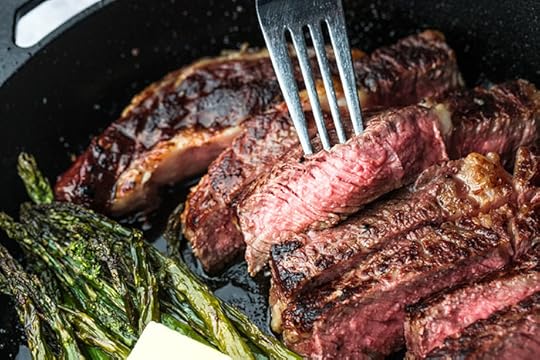
A thermometer is the most accurate way to gauge if steak is done to your liking. Although your thermometer will probably tell you that 145 degrees is rare for beef, any chef you ask will tell you differently.
Temperatures for Steak Doneness
Rare: In a chef’s mind, rare means very pink, is closer to 125 degreesMedium-rare: You’re looking for 125-130 degreesMedium: 130-135 degreesMedium-well: 135 to 140 degreesWell done: 140 and aboveYou can also give the steak a poke with your finger. Rare is squishy, medium-rare is spongy, and medium-well is taut. The steak will continue to cook at least five degrees when it’s off the grill or out of the pan, so err on the side of taking it away from heat earlier rather than later.
Do Not Skip This Step When Cooking SteakThe final step, which should be included no matter how you cook your steak, is letting the meat rest before cutting into it. As the meat cools down the proteins begin to firm up and hold moisture, so when you cut into the steak all the juicy goodness won’t run out. About 8-10 minutes should do it, and a loose cover of foil or no cover at all is a much better choice than tightly sealing the meat up while it rests. If you’re like us, it takes at least 8-10 minutes to set the table and get everyone to sit down, so usually this step simply happens without having to think about it.
Hungry yet? Get over to your local butcher shop, grab a little salt and pepper, and give one of these cooking methods a try. In less time than it takes to drive to a restaurant, you’ll be sitting down at your kitchen table with a tender, sizzling hot, and dare we stay it, perfect steak on your plate.


The post How to Buy and Cook the Perfect Steak appeared first on Mark's Daily Apple.



May 7, 2021
New and Noteworthy: What I Read This Week — Edition 129
 Research of the Week
Research of the WeekThe human cerebellum stands out.
Postprandial glucose dips predict subsequent appetite.
Probiotics seem to help against COVID.
A study into set and setting in a Brazilian ayahuasca church.
Humans attribute more moral standing to animals they deem beautiful.
Feeding a Western diet to mother rats increases omega-6 content and lowers MCT and saturated fat content of the milk.
Episode 489: Autumn Fladmo Smith: Host Elle Russ chats with Autumn Fladmo Smith, who used paleo to resolve IBS and anxiety and eventually go on to found Wild Pastures and Paleo Valley.
Episode 490: Dr. Anthony Balduzzi — The Fit Father Proejct: Host Brad Kearns chats with Dr. Anthony Balduzzi about fit fatherhood.
Health Coach Radio: Erin and Laura chat with Debora Wayne about the fact that everything is energy.
Media, SchmediaInteresting Blog PostsSocial NotesEverything ElseNever thought I’d see this: the genetics of psychic ability.
Nutrient gaps in complementary feeding in East Africa, Southern Africa, and South Asia.
Things I’m Up to and Interested InInteresting effect: A single shot of testosterone increases attraction to novelty.
This is why I eat chicken tikka masala postworkout: Curcumin for DOMS.
He’s right, you know: Do not dwell. Act!
We need more wild horses: They dig wells.
Interesting study: Fossil apes and human evolution.
Question I’m AskingAre you dwelling or are you acting?
Recipe CornerPeople don’t grill enough carrots.Paleo Jamaican brown stew.Time CapsuleOne year ago (May 1 – May 7)
No Equipment at Home Arm Workout (12 Minute EMOM with Video) — No excuses.Floor Sitting: Do You Spend Enough Time on the Ground? — Well, do you?Comment of the Week
“Myths are the poetic, archetypal, yes Paleo/Primal foundation of Sapien consciousness. Please reconsider using myth as a synonym for false belief.”
-Good point, Chris.
(function($) { $("#dfHylJP").load("https://www.marksdailyapple.com/wp-ad..." ); })( jQuery ); 
The post New and Noteworthy: What I Read This Week — Edition 129 appeared first on Mark's Daily Apple.



May 6, 2021
The Best Way to Hydrate, According to a Health Coach
We’re all looking for the perfect formula, right? Just tell me how many grams of fat and carbs to eat. How many steps to take per day. And how many glasses of water I should be drinking within a 24-hour period.
We love the precision of it all. The safety of micromanaging every detail of our life with the promise that if we can dial it in enough, we’ll enjoy perfect health for the rest of our days. But when you think about all the forcing, measuring, counting, and obsessive overplanning that goes into this kind of micromanagement, there’s actually nothing healthy about it.
There’s nothing healthy about ignoring your body’s own cues in favor of what general nutrition — or random social media influencers say. Nutrition might be a science, but it’s also an art form. And learning to trust your body and what it’s trying to tell you trumps any water-to weight-ratio chart you’ll find online.
I’ve always followed Mark’s wisdom around water consumption. We both believe that the body has a well-regulated system for preventing dehydration and a built-in mechanism to let you know when we need more water. That internal mechanism is called your thirst.https://sitn.hms.harvard.edu/flash/20...
How much water you need is highly individual. Meaning, it depends on your unique circumstances, your activity level, and the climate you live in. Not only that, the advice to drink eight 8-ounce glasses of water a day or half your bodyweight in ounces isn’t based on actual evidence.
Those guidelines initially game from the U.S. Food and Nutrition Board recommendations back in 1945, stating that people should drink 2.5 liters of water per day.https://www.abc.net.au/health/thepuls... Unfortunately, people who read that statement neglected to read the following sentence that read, “Most of this quantity is contained in foods.”
I know meditation is good for me, but I don’t know how to start.
I’ve tried to meditate before, but my mind is too busy.
It sounds easy, but it feels hard.
Not sure what the hype is all about? Find out why millions of people have been meditating for thousands of years.
Meditate with us for 21 days, complete with video meditations, a tracker, and community support!
Caffeinated Drinks Work Against You, Right?A review published in the American Journal of Physiology goes even further to debunk the 8 glasses or 2 liter of water per day recommendation. Researchers looked at studies that measured the food and fluid intake of 28,081 men and women in the United States and found that such large volumes of water weren’t necessary for good health.https://journals.physiology.org/doi/f...
They also found that caffeinated drinks (and to a lesser extent, alcohol) added to hydration levels, specifically noting that nearly one-half (47%) of the total fluids ingested by participants were coffee, tea, soft drinks, and alcohol.
So, as a health coach, I don’t push the hydration issue. Instead, I empower my clients to tune into something I think most of us don’t have a good handle on. And that’s trusting your body.
What If You Drank When You Were Thirsty?And while you’re at it, how about eating when you’re hungry, sleeping when you feel tired, and speaking up when you’ve got something to say? Wouldn’t that be miraculous? It would be so freaking liberating to stop forcing every single detail and instead, have a little faith that your body knows what it’s doing.
The trust your body message is something that gets lost in today’s world. In fact, we work extra hard to ignore those subtle and not-so-subtle signs. In fact, humans are the only species that exerts energy when they don’t need to.https://www.inc.com/jessica-stillman/...
We deprive ourselves of sleep on purpose because there’s more work to crank out, or it’s too early to go to bed. We snub our hunger pangs because we tell ourselves we shouldn’t eat ‘til our fasting window opens if we want to lose weight.
We’ve become so used to ignoring and pushing through the discomfort that we’ve forgotten how to honor the miracle that is our body. I’m not saying you shouldn’t push yourself. But by training your brain to disregard the signs and symptoms, you’re doing yourself and your wellbeing a disservice.
Want to Know the Best Way to Hydrate?From a health coaching perspective, the best way to hydrate is get tuned in to what your body is telling you. No one knows you better than you do. And when you get really dialed into your internal signals (instead of continuing the pattern of ignoring them), you don’t have to subject yourself to tracking your water intake — or monitoring your macros for that matter.
Notice what thirst feels like. We’ve become so used to fighting hunger pains, pulling all-nighters, and completely disregarding our body’s signals, that being disconnected is kind of the new normal. But when your body is feeling something, anything, you should always take it as a sign. Pay attention to when your mouth gets dry, or you get a slight itch in the back of your throat. That’s your body telling you its thirsty.Respond to that feeling. Once you’ve learned how to notice what’s going on, the next step is to take action. Respect your body enough to give it what it’s asking for. Go get some water, drink a smoothie, have a cup of coffee. When you consciously respond to these signals, you begin to trust your body more. And vice versa.Hone your self-efficacy skills. In other words, if you believe you can do it, you’re more likely to actually do it. Even if you’re not naturally inclined to think this way, you can learn to have more self-efficacy by setting small goals for yourself (notice when you’re thirsty and go grab some water), being aware of your patterns (ignoring your body’s signals), and getting up to refill your water glass anyway.Stop worrying about what others are doing. A quick search for “how much water should I drink” brings up hundreds of thousands of results ranging in answers from two liters to fifteen and a half cups. Like I said before, no one knows your body better than you. So instead of stressing over what other people are doing (or saying), keep working steps one through three and tune into your own perfect formula.Four Ways to Hydrate BetterForget the 8×8 rule or recommendations to drink half your bodyweight in ounces. The best way to hydrate is to listen to your body. Use these steps to practice tuning into your body’s internal signals, and drink when you’re thirsty. You’ll stay hydrated without having to micromanage your water intake.
Notice what thirst feels likeRespond to that feelingHone your self-efficacy skillsStop worrying about what others are doingNow it’s your turn. How do you decide how much water to drink?
(function($) { $("#df0Egal").load("https://www.marksdailyapple.com/wp-ad..." ); })( jQuery );
References https://sitn.hms.harvard.edu/flash/2019/neuroscience-thirst-brain-tells-look-water/https://www.abc.net.au/health/thepulse/stories/2005/09/15/1460760.htmhttps://journals.physiology.org/doi/full/10.1152/ajpregu.00365.2002https://www.inc.com/jessica-stillman/5-ways-youre-making-life-harder-than-it-has-to-be.html
The post The Best Way to Hydrate, According to a Health Coach appeared first on Mark's Daily Apple.



Mark Sisson's Blog
- Mark Sisson's profile
- 199 followers




